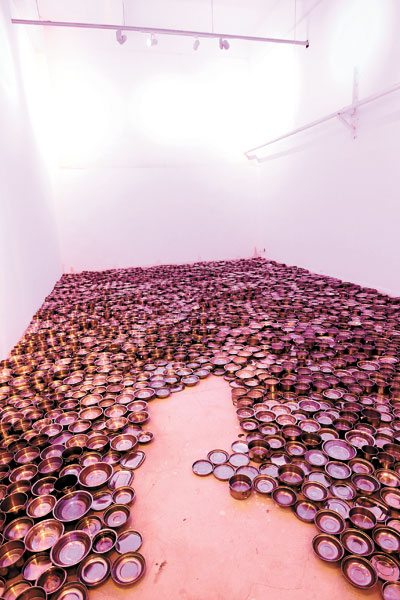
Cao Zhen
caozhen0806@126.com
IT was not overnight that art went from something you see to something you do. The OCT Contemporary Art Terminal (OCAT) is hosting the Eighth Shenzhen Sculpture Biennale, featuring artworks that require participation from visitors.
Curated by Marko Daniel, the biennale isn’t limited to sculptures, but also exhibits other forms of artwork, such as videos, paintings, photography and installations created by 33 artists from 13 countries and regions. “The biennale takes its lead from the notion of social sculpture, originally developed by Joseph Beuys who expanded the concept of sculpture beyond material objects into social relations. His challenge to build a ‘social organism as a work of art’ is one of the sources of relational and participatory art,” said Daniel, convenor of public programs at Tate Modern and Tate Britain.
At the exhibition, participatory art comes in many forms. Some works are playful, like Manuel Saiz’s “Public Display of Affection,” an interactive video installation. The work consists of a simple film studio setup that re-creates a particular shot similar to the typical ending of romantic movies, the moment in which a couple finally falls into each other’s arms and kiss. The camera revolves around the couple. The artist installs a camera on a revolving toy train to get a panoramic view around each couple.
Saiz said the entire process lets participants experience the limits of reality and fiction. It’s also about the concept of intimacy in the public realm and represents a “moment of fascination” for participants and spectators. The project was exhibited in Newcastle, Britain in 2007 and Madrid, Spain in 2010. In Shenzhen, the OCAT invited viewers to create their own version of this shot last Saturday at the exhibition. The camera recorded as lights dimmed and music faded in. Each shot of each couple lasted 30 seconds, and the videos were shown live on a monitor outside of the studio. Viewers will have another opportunity to participate in the project this Saturday afternoon at 2 p.m.
Participatory art can also be as simple as U.S. artist Marc Lafia’s “Art as Invention 4, Public Relations.” It features just three colored chalk boards that act as a low-tech version of social media. People write questions or topics on the boards and viewers can write any response they wish. The responses are both interesting and trivial. The project provokes interaction and highlights the fleeting nature of discourse, according to Lafia.
Finnish artists Tellervo Kalleinen and Oliver Kochta-Kalleinen have brought their world-famous project, “Complaints Choir,” to the Chinese mainland for the first time. It is a joyful gathering of people who sing about their complaints together as a choir. The OCAT is inviting locals to complain and their complaints are subsequently transcribed into lyrics and set to music. Rehearsals are this Saturday afternoon at OCT-LOFT and the performance will be June 14 afternoon at OCT Ecological Square.
The first Complaints Choir was organized in Birmingham, Britain in 2005. After it became a surprise success, Kalleinen and Kochta-Kalleinen were invited to initiate Complaints Choirs all around the globe. They have recorded all of the performances and present the videos at art exhibitions. There are around 100 complaints choirs around the world. The artists believe there is a large need for a musical outlet for people’s gripes.
Curator Daniel said participatory art can be traced back to the 1960s, and this way of making art has become part of the toolset of contemporary art. The biennale also includes a research station which combines documentation, an archive and a library in OCAT Hall A. There will be an extensive public program of talks and events around the exhibition, involving both participating artists and other invited speakers.
Dates: Until Aug. 31, closed Mondays
Venues: OCAT (South Area), B10 (North Area), OCT-LOFT, Nanshan District (南山区华侨城创意文化园南区当代艺术中心和北区B10)
Metro: Luobao Line, Qiaocheng East Station (侨城东站), Exit A
|

